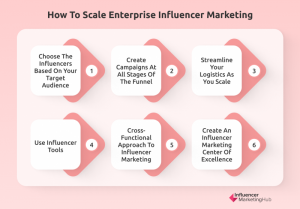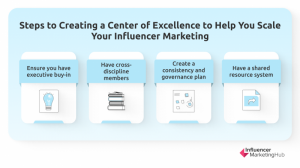All types of businesses use influencer marketing, from small businesses, even solopreneurs occasionally, to the largest corporations and entities. And technically, the process is the same no matter what your size. But if you are part of an enterprise, you'll know that things tend to be done differently, partly due to increased resources but also due to there being more stakeholders with varied needs and a requirement for more formalized systems and processes.
Scaling influencer marketing is not merely a case of spending more money on influencers. If you are ten times the size of a competitor, it doesn't mean you should allocate an influencer marketing budget ten times what they do. Nor does it mean that you only deal with popular macro- and mega-influencers, rather than the micro-influencers who are the mainstay of influencer marketing, just because you can afford their fees. Instead, you must think carefully about the influencers who will work best with your target market. And if that means using vast numbers of small-scale micro- and even nano-influencers, then you will need to develop sound policies to cope with the administration required.
Scaling Enterprise Influencer Marketing:
- Big is Not Always Better with Influencer Marketing
- It All Depends on Your Target Audience
- Work With Influencers at All Stages of the Purchasing Funnel
- You Will Need to Streamline Your Logistics as You Scale Your Influencer Marketing
- Use Influencer Tools to Simplify the Process
- Cross-Functional Influencer Marketing
- The Influencer Marketing Center of Excellence
- Best Practices for Influencer Marketing Centers of Excellence
- Steps to Creating a Center of Excellence to Help You Scale Your Influencer Marketing
Big is Not Always Better with Influencer Marketing
On the surface, it seems simple. You can choose virtually anybody to represent your brand if you have deep marketing pockets. Therefore, shouldn't you select famous celebrities and other well-known faces to represent your brand online? Haven't enterprise brands been engaged in celebrity marketing for years, even before the dawn of social media and influencer marketing?
But alas, it doesn't work that way. You may be big, but you're just a big brand to consumers as they scan their Instagram feeds, flick through TikTok videos, and read blog posts on their favorite topics. They probably already know who you are and have preconceived opinions about your product. And just because a famous model, sportsperson, or actor suggests to their followers that they should purchase your product in a social media post doesn't mean that they will rush out in droves to do so. Sorry to disappoint you, but "influence" on social media isn't about fame and popularity, despite what the headlines may tell you. Influencer marketing is all about people listening to the views of the thought leaders they respect or at least noticing the recommendations these online superstars make in their posts, images, and videos. You might wonder how we can call someone who garners millions of views from making fart videos on TikTok an influencer. But if they consistently pull in viewers with such videos, they clearly can influence a particular type of audience. And if their audience matches your target market, they may be an ideal influencer to market your product.
Sometimes the best approach to scaling influencer marketing isn't to suddenly make high-profile influencer campaigns using hundreds of influencers. Instead, even enterprise-sized companies may deliver better results by starting small, getting to know a few influencers and their audiences, and then gradually scaling to more extensive campaigns with more significant numbers of popular influencers.
In our most recent State of Influencer Marketing Benchmark Report, we saw that two-thirds of our respondents intended to spend between 10% and 30% of their marketing budget on influencer marketing. So that is probably a good guide of the funds to allocate to influencer marketing, starting near the bottom of that range and increasing your spending as you experience success.
It All Depends on Your Target Audience
The core idea behind influencer marketing applies as much to enterprises as it does to other organizations. You will usually set a goal for each campaign. And you have to find the best combination of influencers who can assist you in meeting that goal.
For example, like any other business, you might choose to run an influencer campaign to increase sales of a specific product by 10%. However, whereas a small company might try to increase sales of their product by $10,000 to $100,000, the enterprise may be hoping to expand their product's sales by $1 million from $10 million to $11 million as a result of this campaign. To do this, they will need to work with sufficient influencers (or sufficiently popular influencers) who have a large enough combined audience of relevant, interested followers likely to try your product, spending $1 million in the process.
You could choose to work with celebrities and mega-influencers with massive followings in the hope that their promotion will flow through to people buying your product. But if they are the "wrong" influencers for your product, with audiences unlikely to be interested in what you're selling, these huge audiences become irrelevant. They are no more likely to buy your product now than before the campaign, no matter how much they admire the famous sportsperson, actor, or model.
It's also essential that the audience believes the influencers genuinely believe in what they're promoting and aren't just "taking the money" or taking advantage of their fame. For example, the Kendall Jenner Pepsi ad of 2017 failed because it came across as a company cashing in on a serious event, Black Lives Matter. By selecting a rich white model, Kendall Jenner, to deliver such an ad at this stage came across as being tone-deaf to many.
Work With Influencers at All Stages of the Purchasing Funnel
One advantage of having a larger budget for influencer marketing is that you can operate multiple influencer campaigns targeting different stages of the purchasing funnel. You could, for instance, simultaneously partner with a group of influencers to raise awareness of your brand, another to build a preference for your products, and a third to push through sales of specific stock items.
Indeed, you could even create an overarching campaign across multiple platforms emphasizing multi-touch engagement.
You Will Need to Streamline Your Logistics as You Scale Your Influencer Marketing
In many ways, enterprise influencer marketing is merely a magnification of small business influencer marketing. Many activities are the same, just on a significantly bigger scale. This means that you will need to ensure that you streamline your logistics. For instance, a small business working with a few influencers can relatively easily send product samples to them, particularly if they live nearby. However, suppose you scale your campaigns to include hundreds of influencers, possibly globally based. In that case, you will need to improve your systems for the logistics and record-keeping of sending out products.
Use Influencer Tools to Simplify the Process
As you scale influencer marketing, you gain value from using some of the many influencer marketing tools and platforms that offer ways to streamline parts of the process. These began by collating massive databases of influencers with various analyses, including their audiences. You can use these platforms to search for influencers based on the characteristics of your target audience.
More recently, the remits of the influencer platforms have expanded. In addition to search and discovery, you will find tools to assist with content amplification, influencer lifecycle management, influencer relationship management, campaign reporting, product gifting, audience analysis, and more.
Many platforms cover influencers on multiple social networks, making it easier for you to create campaigns that reach audiences on Instagram, TikTok, YouTube, Facebook, and more.
Cross-Functional Influencer Marketing
A recent trend for enterprises and large businesses is to take a cross-functional approach to influencer marketing. Depending on the campaign, many parts of your organization could connect with and advise the influencers with whom you partner.
For example, while it may be your head office marketing team who plans the campaign (possibly with the assistance of an influencer marketing agency), members of your production team may give an insight into the production process to your influencers, and your sales team may help demonstrate a product's benefits.
The more influencers you partner with, the better it is to encourage this cross-functional approach. It takes the pressure off your marketing team by widening the range of people that influencers can approach. At the same time, it gives others within your team the opportunity to display their knowledge and expertise.
The Influencer Marketing Center of Excellence
This provides an opportunity for enterprises to create an Influencer Marketing Center of Excellence, particularly if you view influencer marketing as a long-term activity rather than merely an experimental campaign. Centers of Excellence bring together people from different disciplines for a purpose. They provide shared facilities and support. Businesses can use them to concentrate their existing expertise and resources in a desired area, in this case, influencer marketing. You could even successfully expand your Influencer Marketing Center of Excellence to cater to those of your employees willing to participate in your employee advocacy program.
You could use your Influencer Marketing Center of Excellence to combine learning and oversight around influencer marketing, driving your organization to shift across multiple disciplines.
For example, suppose you are an enterprise with multiple divisions and products. In that case, you could include the heads of marketing-related functions from across your different product lines in an Influencer Marketing Center of Excellence to implement influencer marketing enterprise-wide, providing content-creation and editorial services and arrange influencer access to the various experts and specialists in your organization. In addition, the Center of Excellence would focus on providing training, best practices, and resources for all of these teams while gathering data and learnings from them.
Best Practices for Influencer Marketing Centers of Excellence
Convince and Convert has examined Centers of Excellence in detail. They saw four best practices to follow with any Center of Excellence. These are:
1. Ensure you have executive buy-in – this can be challenging if you have skeptical team leads concerned that they might lose their independence
2. Have cross-discipline members – bring together the best people from all sections of your organization who could provide the expertise that will improve your influencer marketing results
3. Create a consistency and governance plan – it makes life much easier for everybody if it's clear who has what responsibilities
4. Have a shared resource system – there is little point in reinventing the wheel. Everybody working as part of the Influencer Marketing Center of Excellence should have access to relevant templates, tools, calendars, and work standards. You will also want to emphasize that all participants should adhere to using the agreed tools and standards to ensure consistency.
Steps to Creating a Center of Excellence to Help You Scale Your Influencer Marketing
You will probably want to consider the following steps when setting up your Influencer Marketing Center of Excellence:
1. Define the scope and nature of your Influencer Marketing Center of Excellence
2. Identify relevant team members across your entire organization with skills to assist with influencer marketing
3. Schedule regular meetings with all relevant stakeholders. Make these virtual if you have multiple sites. In addition, set up effective communication channels between all participants
4. Create a resource hub using the skills of your team and consistent tools and templates to assist the influencers with whom you'll partner
There is no rule for where your Center of Excellence should sit within your organization, i.e., who should oversee it. Existing enterprises have tended to give responsibility to some combination of Communications, Marketing, and/or Social Media.
Typically, Influencer Marketing Centers of Excellence take responsibility for an enterprise's
- Influencer marketing best practices and strategies, including setting overall goals with measurable KPIs and rules of influencer engagement
- Training to internal stakeholders in such areas as influencer outreach, influencer relations, and the available tools
- Technology management, including best practice systems and resource allocation between stakeholders
- Influencer management, including training subject matter experts, influencer outreach, facilitating meetings and identifying partnership opportunities
- Influencer selection, typically using an influencer marketing platform or coordinating with an influencer marketing agency
- Relationship building, ensuring harmonious relations between all stakeholders, both internal and external, including influencer partners
- Developing and reporting on standardized KPIs related to the enterprise's overall influencer marketing goals, allied with specific goals tailored for each campaign. Over time the Influencer Marketing Center of Excellence can produce relevant benchmark reports as the enterprise build a library of historical data
- Ensuring that all participants in the enterprise's influencer marketing campaigns abide by all relevant regulatory requirements




